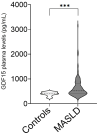Levels of Growth Differentiation Factor 15 Correlated with Metabolic Dysfunction-Associated Steatotic Liver Disease in Children
- PMID: 40650260
- PMCID: PMC12249647
- DOI: 10.3390/ijms26136486
Levels of Growth Differentiation Factor 15 Correlated with Metabolic Dysfunction-Associated Steatotic Liver Disease in Children
Abstract
Metabolic dysfunction-associated steatotic liver disease (MASLD) is the most common chronic progressive hepatopathy in children, and the identification of non-invasive biomarkers is urgently needed. Growth differentiation factor 15 (GDF15) was associated with MASLD in adults. In this study, we investigated the circulating and hepatic levels of GDF15 and their association with liver damage in pediatric MASLD and in a murine model. This observational study included 158 children with biopsy-proven MASLD. Patients with MASLD were categorized into two groups based on steatohepatitis (MASH) presence and evaluated for GDF15 circulating levels, while GDF15 hepatic levels were assessed only in a subset of patients. Children with MASLD exhibited higher levels of circulating GDF15 compared to the controls. Moreover, the MASH subgroup had significantly higher values of GDF15 compared to the Not-MASH subgroup. The GDF15 levels in the MASH subgroup showed a positive correlation with fibrosis. Finally, the hepatic expression of the GDF15 gene correlated with GDF15 circulating levels and with the hepatic expression of the COL1A1 and COL3A1 genes in 15 children with MASLD. In conclusion, our study demonstrated that GDF15 levels are associated with liver damage, reinforcing the potential role of GDF15 as a biomarker for MASLD-related fibrosis in children.
Keywords: GDF15; MASH; MASLD; children; hepatic steatosis; insulin resistance; liver fibrosis; metabolic syndrome; obesity; tissue injury.
Conflict of interest statement
The authors declare no conflicts of interest. The funders had no role in the design of the study, in the collection, analysis, or interpretation of data, in the writing of the manuscript, or in the decision to publish the results.
Figures





References
-
- Eslam M., Newsome P.N., Sarin S.K., Anstee Q.M., Targher G., Romero-Gomez M., Zelber-Sagi S., Wong V.W.-S., Dufour J.-F., Schattenberg J.M., et al. A new definition for metabolic dysfunction-associated fatty liver disease: An international expert consensus statement. J. Hepatol. 2020;73:202–209. doi: 10.1016/j.jhep.2020.03.039. - DOI - PubMed
-
- Vali Y., Lee J., Boursier J., Petta S., Wonders K., Tiniakos D., Bedossa P., Geier A., Francque S., Allison M., et al. Liver Investigation: Testing Marker Utility in Steatohepatitis (LITMUS) consortium investigators. Biomarkers for staging fibrosis and non-alcoholic steatohepatitis in non-alcoholic fatty liver disease (the LITMUS project): A comparative diagnostic accuracy study. Lancet Gastroenterol. Hepatol. 2023;8:714–725. doi: 10.1016/S2468-1253(23)00017-1. - DOI - PubMed
Publication types
MeSH terms
Substances
Grants and funding
LinkOut - more resources
Full Text Sources
Miscellaneous

